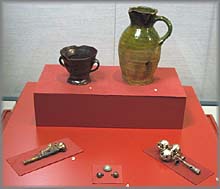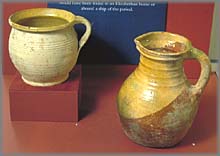
|
 nly a few scattered hints tell us of the lives that these people led aboard ship, and later in England. We know that they were very courteous to one another and cared about each other's welfare. They enjoyed music, and quickly learned English songs. nly a few scattered hints tell us of the lives that these people led aboard ship, and later in England. We know that they were very courteous to one another and cared about each other's welfare. They enjoyed music, and quickly learned English songs.
|
"These people are in nature verye subtil, and sharpe witted, readie to conceiue our meaning by signes, and to make answere, well to be vnderstoode againe....They will teache vs the names of eache thing in their language, which we desire to learne, and are apt to learne any thing of vs. They delight in Musicke aboue measure, and will kepe time and stroke to any tune which you shall sing, both with their voyce, heade, hande and feete, and wyll sing the same tune aptlye after you."
"They are exceedingly friendly and kinde harted one to the other, & mourne greatly at the losse or harm of their fellowes, and expresse their griefe of minde, when they part one from an other, with a mournefull song, and Dirges."
"They wondred muche at all our things, and were afraide of our horses, and other beastes, out of measure. They beganne to growe more ciuill, familiar, pleasaunt, and docible amongst vs in a verye shorte time."
(George Best's account of the 1578 voyage)

|

 |
 |
ivory needle case and thimble holder
(TkAu-1:3, TkAu-1:2)
When the English visited abandoned Inuit settlements, they were fascinated by the complex and ingenious tools and weapons that they found. Inuit technology was based largely on animal bones and ivory, although the English noted several metal objects which had been obtained in trade.
These artifacts were excavated from archaeological sites in the eastern Arctic, and are probably very similar to those used by the Inuit who encountered Frobisher. |

 |
|
| Just as the English were curious about Inuit technology, the Inuit hostages must have been fascinated by the tools and utensils that they saw aboard ship and during their stay in England. This selection of objects is characteristic of the items that would have been found in an Elizabethan home or aboard a ship of the period. |
 |
| Photograph: Steven Darby |
 |
| Photograph: Steven Darby |
|


|

